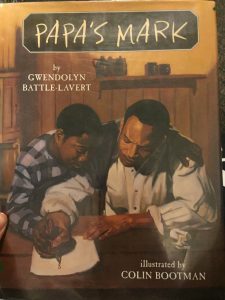 Author(s): Gwendolyn Battle-Lavert
Author(s): Gwendolyn Battle-Lavert
Illustrator/Photographer: Colin Bootman
Publisher and Year: Holiday House in 2004
Number of Pages: 30
Genre: Historical Fiction
Analysis:
This book is the story of how an African American boy named Simms, helped his father in becoming one of the first African Americans to vote in an election. Simms’s father does not know how to sign his name other than by just making a mark, therefore, Simms helps him learn how to write his name and encourages him and other African American men to vote in the election. In the end, Simms’s father and many other African American men vote despite any prior fears or uncertainties.
This book could serve as a window into seeing the injustice that many African Americans have faced, and still do today. This book could also function as a mirror for African American children, in which they may recognize the value of their culture and the role they play, as children, in their culture. I also believe that this story is a door for all people to really begin to recognize the racism that is still present in our world today, and encourage children to become advocates for their culture and their rights as humans. The illustrations that accompany the story portray the characters in a very accurate way, from the way they are dressed, to the expressions on their faces. The colors used throughout the book are fairly dark with a yellow and brown color scheme, which can represent the confinement felt by the African Americans in this book.
I thought that the author accurately described the challenges that faced many African Americans during the Civil Rights movement, and even after they earned the right to vote. This book does not go into much detail of what had happened in order for the African Americans to have the right to vote, but it does explain how literacy was one challenge for many African Americans and also the fear of what might happen to them if they do vote. Also, all throughout the story, Simms is always around to help his father like picking up groceries, teaching his father how to spell his name, making posters, and encouraging both his father and other African American males to vote which shows children that they are capable of helping their elders and making a difference in social justice situations. Simms can also be considered a symbol of younger generations and the huge impact they have on continuing the fight for civil rights.

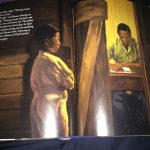
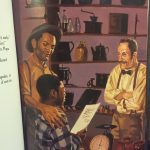
 Title: Stand Tall Molly Lou Melon
Title: Stand Tall Molly Lou Melon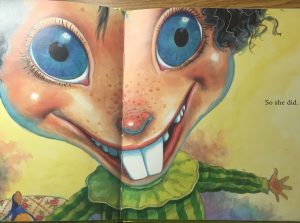 e did” shows the reader that Molly Lou Melon took her grandmother’s advice to heart. The lack of frames in the illustrations allows the reader to connect to Molly Lou Melon on a personal level. Ideologically, this book has many layers. One layer shows that if people stand up to bullies, the bullying stops. Each time Ronald Durkin bullied Molly Lou Melon, she did something that all her other classmates loved. Eventually Ronald Durkin stopped bullying her. The second layer teaches children to love who they are and what they look like. Molly Lou Melon has a lot of self confidence when it comes to doing anything. Molly Lou Melon’s grandmother teaches her that she can accomplish anything if she carries herself with confidence, and that’s just what she does. This book teaches children to value self confidence and individuality.
e did” shows the reader that Molly Lou Melon took her grandmother’s advice to heart. The lack of frames in the illustrations allows the reader to connect to Molly Lou Melon on a personal level. Ideologically, this book has many layers. One layer shows that if people stand up to bullies, the bullying stops. Each time Ronald Durkin bullied Molly Lou Melon, she did something that all her other classmates loved. Eventually Ronald Durkin stopped bullying her. The second layer teaches children to love who they are and what they look like. Molly Lou Melon has a lot of self confidence when it comes to doing anything. Molly Lou Melon’s grandmother teaches her that she can accomplish anything if she carries herself with confidence, and that’s just what she does. This book teaches children to value self confidence and individuality. Title: My Mom’s Having a Baby
Title: My Mom’s Having a Baby hat the baby has finger nails, eyes, and ears. It shows the actual size of the embryo at this point in the pregnancy. When Elizabeth wonders how the baby got there, the process of creating a baby is explained. The images include the human anatomy of the female and the male as well as an honest explanation of how the baby got there. The images are pencil drawings with some water color. The use of text bubbles emphasizes the idea that the questions asked in this book are common from children who are expecting to be a big brother or sister. The text in the bubbles also resembles a child’s handwriting, giving it a sense of authenticity.
hat the baby has finger nails, eyes, and ears. It shows the actual size of the embryo at this point in the pregnancy. When Elizabeth wonders how the baby got there, the process of creating a baby is explained. The images include the human anatomy of the female and the male as well as an honest explanation of how the baby got there. The images are pencil drawings with some water color. The use of text bubbles emphasizes the idea that the questions asked in this book are common from children who are expecting to be a big brother or sister. The text in the bubbles also resembles a child’s handwriting, giving it a sense of authenticity.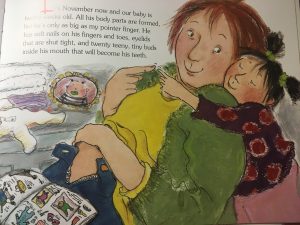
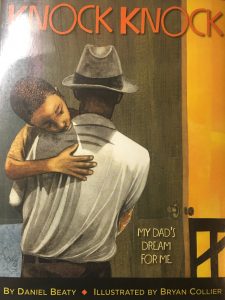 Author: Daniel Beaty
Author: Daniel Beaty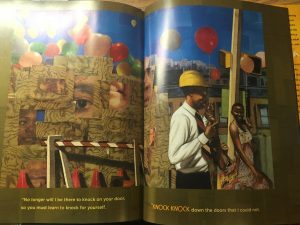 he couldn’t, as well as knock to open the doors to his dreams. This element ties into the game they used to play when he as a child. Ideologically, this book has many important lessons. While it speaks to the children who have lost a parent, it also aims to show hope, the importance of making good decisions, and to not let a past define a future. This book speaks to all children who may have the odds stacked against them. Some people may believe that this book is stereotypical because the father, an African American, is sent to jail. However, I believe that this book is great for all children, regardless of their situation.
he couldn’t, as well as knock to open the doors to his dreams. This element ties into the game they used to play when he as a child. Ideologically, this book has many important lessons. While it speaks to the children who have lost a parent, it also aims to show hope, the importance of making good decisions, and to not let a past define a future. This book speaks to all children who may have the odds stacked against them. Some people may believe that this book is stereotypical because the father, an African American, is sent to jail. However, I believe that this book is great for all children, regardless of their situation.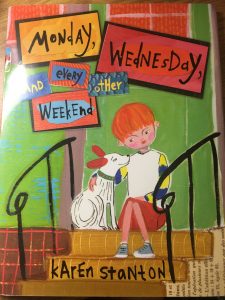 Author: Karen Stanton
Author: Karen Stanton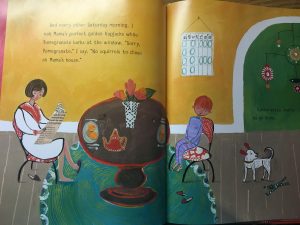 e days that Henry will spend there. The author and illustrator uses Pomegranate to display most of the emotions felt by children during times of divorce within their family. For example, Pomegranate runs away and Henry knows just where to find him. Henry runs to his old house, “the house where we all used to live together,” and finds Pomegranate there. However, she portrays the main character Henry as happy and well adjusted to his new life, but does not underplay the emotions Henry experiences. The author also portrays each parent positively, listing the perks of living in each house. While searching for the dog, the illustrator creates a map that allows the reader to see the town in which Henry lives. The dots on the map show where Henry goes to find his dog. This book handles the feelings surrounding divorce in a positive way. This book can be used by families who are struggling to establish a new way of living after divorce. This book is relatable to a lot of children who experience this shift in family dynamics.
e days that Henry will spend there. The author and illustrator uses Pomegranate to display most of the emotions felt by children during times of divorce within their family. For example, Pomegranate runs away and Henry knows just where to find him. Henry runs to his old house, “the house where we all used to live together,” and finds Pomegranate there. However, she portrays the main character Henry as happy and well adjusted to his new life, but does not underplay the emotions Henry experiences. The author also portrays each parent positively, listing the perks of living in each house. While searching for the dog, the illustrator creates a map that allows the reader to see the town in which Henry lives. The dots on the map show where Henry goes to find his dog. This book handles the feelings surrounding divorce in a positive way. This book can be used by families who are struggling to establish a new way of living after divorce. This book is relatable to a lot of children who experience this shift in family dynamics.



![2016-05-10_00.47.03[1]](https://blogs.iwu.edu/lrbmt2016/files/2016/05/2016-05-10_00.47.031-200x300.jpg)
![2016-05-10_00.43.28[1]](https://blogs.iwu.edu/lrbmt2016/files/2016/05/2016-05-10_00.43.281-300x225.jpg)
![2016-05-10_00.48.04[1]](https://blogs.iwu.edu/lrbmt2016/files/2016/05/2016-05-10_00.48.041-300x266.jpg)
![2016-05-10_00.39.24[1]](https://blogs.iwu.edu/lrbmt2016/files/2016/05/2016-05-10_00.39.241-300x143.jpg)


